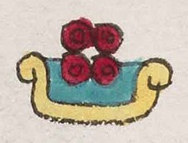Atonal (Mdz7v)
This colorful compound glyph for the personal name Atonal (perhaps "Water," the day sign Dzawindanda in Mixtec) includes two components. One is the water (atl), which provides the phonetic for the start of the name ("A-") but is also a day sign in religious 260-day divinatory calendar, and the other is the symbol for day (tonalli). The water, in this case, is represented by what we might have thought was an apantli (canal), but here it just reads water. It is a cross-section of a canal with the usual turquoise blue water, but it does not have wavy black lines or droplets/beads and turbinate shells splashing off the top. The canal has a yellow liner, and the liner curls are the top on both the right and the left, which is something seen in some glyphs and not in others. The two we share below, right, both also have curling corners, and in both these cases atl is meant rather than apantli.
Stephanie Wood
The name, Atonal or Atonalztin, would appear to be a calendrical one, perhaps based on the day the man was born. Tonalli not only referred to a day, but also to the sun, to summertime warmth, and heat, according to examples from our Online Nahuatl Dictionary. More than that, the tonalli "was a sort of soul, located in the crown of the head, that regulated body temperature and growth and played a major role in determining a person's character and fate. Tonalli loss resulted in illness and, if healing ceremonies were not performed, death," according to Louise M. Burkhart, Holy Wednesday: A Nahua Drama from Early Colonial Mexico (Philadelphia: University of Pennsylvania Press, 1996), 190.
This Atonal is a male. According to Wikipedia, an Atonal II had the Mixtec name of Dzawindanda, and as the contextual image shows, he ruled Coixtlahuaca in the mid-15th century. He was executed when the Aztecs conquered his city under Motecuhzoma I. Some 160 pochteca (long distance traders) from central Mexico had been executed first, apparently. Archaeological remains at Coixtlahuaca include many artifacts that reveal a robust trade with central Mexico and possibly the presence of a Nahua colony.
The tonalli of water may further refer to its shimmer, vibrance, or resplendence--all terms for shine or gleam that refer more to movement.
Stephanie Wood
c. 1541, but by 1553 at the latest
Stephanie Wood
nombres de hombres, nombres famosos, personas famosas, Mixtecos, calendarios, días, agua, sol, canales, tonales, fuerzas animadoras, religión indígena, tonalpohualli

a(tl), water, https://nahuatl.wired-humanities.org/content/atl
tonal(li), a day, the sun, or a solar energizing force, https://nahuatl.wired-humanities.org/content/tonalli
"Water Day" or "Water Summertime" (Berdan and Anawalt, 1992, vol. 1, p. 233)
Agua, o posiblemente, Brillo de Agua
Codex Mendoza, folio 7 verso, https://digital.bodleian.ox.ac.uk/objects/2fea788e-2aa2-4f08-b6d9-648c00..., image 25, of 188.
Original manuscript is held by the Bodleian Libraries, University of Oxford, MS. Arch. Selden. A. 1; used here with the UK Creative Commons, “Attribution-NonCommercial-ShareAlike 3.0 License” (CC-BY-NC-SA 3.0)








